Global Perspectives on and Research Challenges for Electric Vehicles
Abstract
:1. Introduction
2. Materials and Methods
3. Results and Discussion
3.1. Analysis of the Communities
- Grid-to-vehicle (G2V) is used in internal chargers.
- Vehicle-to-everything (V2X) uses bidirectional integrated chargers and allows distributed energy control to share stored energy. However, V2X is vulnerable to cyber–physical attacks and instability caused by time delay. There are proposals to solve this by using cyber resilience techniques, authentication protocols, and delay-tolerant techniques, through which the resilience of the V2X system to cyber–physical attacks and time delays can be increased.
- Vehicle-to-grid (V2G) uses the energy stored in the battery for the grid connection to provide services to the grid (active power demand regulation, reactive power compensation, peak shaving and valley filling of load demand, frequency and voltage regulation, harmonic compensation of grid current, improved reliability, and stability and efficiency of the system, among others).
- Vehicle-for-grid (V4G) is a special case of the V2G mode of operation to compensate harmonics in the line current and inject reactive power to improve the voltage profile of the system; it allows the G2V/V2G mode, and the remaining energy not used in this mode can only be used for reactive and harmonic power compensation during the V4G mode.
- Vehicle-to-vehicle (V2V) is used to exchange charging energy between EVs, where EV owners can sell their surplus energy to other EV owners. This functionality can also be realized by V2V for EVs connected to smart homes and car parks.
- Vehicle-to-home (V2H) implements the V2G modes to provide a backup supply for connected loads in the home (connected appliances in a smart home) and V2V.
- Vehicle-to-load (V2L) is used to ensure a continuous supply to critical loads that cannot be left without power in case of main grid failure such as military sites, hospitals, data centers, etc. It is implemented as a special case of the V2H and V2V modes of operation for electric vehicle chargers.
3.2. Analysis of Authors and Documents on the Topic of EVs
3.3. Future Perspectives and Challenges
- Optimized charging techniques are required to balance charging time and battery life and also to incorporate additional protection to balance battery temperature during the charging process in order to avoid battery degradation [58]. Battery heating is a serious problem in the case of external charging, as external charging to increase the efficiency of charging stations mainly depends on the selection of power converter topologies [119].
- The latest generation of EVs have the vehicle-to-everything (V2X) mode of operation. Extensive research in the domain of power density, power level, converter topologies, and control techniques related to the V2X system is required to expand its commercialization. The implementation of the V2X system has an important role to play in future EVs [60].
- Among the technical challenges of future EVs is the coordination between different emerging charging technologies such as V2X, V2G, and VG4 [60].
- The modes of operation between G2V and V2G must solve the following challenges: transformer ageing, battery degradation and energy loss, harmonic distortion, voltage profile deterioration, and charging curve variation [119].
- Successful communication techniques are required, in which a communication link is created between charging and EV systems. Communication vulnerability (cyber-attack) and communication delay are among their challenges. In addition, it is recommended to integrate various vehicular communication technologies such as wireless access to meet the communication needs of various use cases [120].
- The challenges facing the fast charging station are to achieve good overall efficiency, reduced harmonics, low capital operating cost, and an efficient control algorithm to control the charging current [58].
- The challenges of the wireless charging station to be solved optimally are the design of the coils, the selection of a suitable compensation network, and the ability to transfer high power over a long distance [58]. Standardized wireless charging systems across different types of charging infrastructure and different classes of electric vehicles also require technological improvements [59].
- A global standard for chargers and connectors is required to make energy transfer more efficient and to standardize the associated systems. Currently there are standards depending on the country and vehicle model; if we want to make progress with EVs we must try to homogenize the criteria for selecting associated standards. Vehicle manufacturers must also agree to use a charging connector standard, although new EVs usually come with dual-connector models depending on the charging mode of operation. The standardization of charging systems and their connectors is a gap that remains to be solved [58].
- Charging times are long, from 3 to 12 h, although 80% can be charged in 30 min when using a fast charger. Public fast chargers are still rare in many cities due to their high investment cost. By having fast charging stations along the roadside, fast charging could play an important role in expanding the range of electric vehicles [121].
- The incorporation of autonomous driving technologies (ADT) in EVs is stimulating for the vehicle sharing industry and EV car sharing. Remaining challenges include planning the size of a fleet, vehicle relocation strategies such as mixed relocation strategies based on operators and users, vehicle route optimization, and government management policies to increase user demand such as parking fees and subsidy strategies.
- Research should be done to consider the spatial and temporal distribution of demand and the influence of dynamic demand-responsive pricing schemes for car sharing including EVs. In addition, subsidies may be the key to EV utilization for passengers with a car sharing platform, such as Uber. How to design subsidy mechanisms to promote EV sharing in a competitive environment, incorporating uncertainties in last-minute bookings, charging levels, driver choice behaviors, and energy prices in the models, are issues that need to be resolved. This topic raises many issues for future research [122].
- Regarding batteries and new charging technology, a battery exchange or leasing market has emerged. The battery leasing model may be more successful than the battery swap model during the early stages of EV adoption because the initial capital costs (land, building a facility, and maintaining a battery inventory) are much higher than the cost of installing a charging station [122]. The study of productive leasing models is based on a standardization of batteries that would limit battery stocking.
- Charging infrastructure can be a productive market, but there are investment and planning issues for charging infrastructure that need to be addressed in the face of the growing number of electric vehicles on the market [123], mainly due to the lack of government regulations and subsidies to support these infrastructures. In addition, this business requires standardization of the infrastructures and optimal planning of their location.
- Many of the potential markets still require profitable short-term business models.
- The social and market acceptability of a different technology than the conventional one is an issue that needs to be addressed. Increased acceptance of EV technology would enable mass production and could make the technology more economically viable for the consumer [58].
- Research on new batteries that have higher capacity, higher energy density, better safety, more efficient battery management, longer life cycles, and that are environmentally friendly [60].
- Higher capacity batteries will encourage the adoption of faster and more powerful charging methods, as well as improved wireless charging technology.
- The energy management system needs improvements to decrease costs and increase the life cycle of batteries; the trend in recent research is hybrid energy systems, but their commercialization requires robustness, low computational complexity, real-time control, accuracy, and overall optimization of the energy management system.
- Studies initially used life cycle assessment (LCA) as a method of assessing the environmental impacts of emerging technologies such as EVs, but it is insufficient to consider the economic and social impacts. Few studies assess socio-economic indicators at the macro level, except for life cycle cost analysis. Many studies link CO2 emission reduction as a precursor to driving EV expansion, but secondary effects, macroeconomic impacts, and impacts related to the global supply chain need to be considered as a comprehensive approach to help decision making in the event of conflicts in technology deployment [124].
- Another remaining challenge is the recycling of batteries, which, as noted, have toxic materials. If batteries are not carefully designed with end-of-life management in mind, dependence will simply shift from one non-renewable source (oil) to others (rare earth metals), which is an important issue for further study for the world’s green revolution [124].
- One remaining challenge is the coupling of the motor and battery for driving conditions and performance requirements (cost, efficiency, driving dynamics, and driving comfort).
- The selection of a power coupling architecture, together with the optimization of both the appropriate component size according to the architecture employed and the control strategy, will be the subject of future research. Although there are many examples of energy-efficient control strategies in the literature, they should be investigated to achieve dynamic coordinated control of the mode switching process, as it has a significant impact on vehicle handling and ride comfort [125].
- Efficiency improvement of the permanent-magnet synchronous motors (PMSM). Among the losses in this class of motors are copper losses, iron losses, friction losses, and dispersion losses. Iron losses have not been considered in previous works; however, several studies have found iron loss to be an important component of the total losses [126]. Therefore, ignoring iron losses will overestimate motor efficiency. Pei et al. (2022) point that copper losses and iron losses are greatly dependent on control strategies [127], and in the near future the PMSM efficiency optimization strategy with time-varying parameters should be studied.
- Increase the power density of the motor. This can be achieved through three approaches: increasing the speed of the motor; the use of new materials in the magnetic circuit, winding insulation, etc.; or the application of new technologies to the motor production [128].
- Direct torque control (DTC) has been used traditionally, but it results in large torque fluctuation. To solve the torque ripple problem, efforts are dedicated in the literature to overcome these issues and various improved methods are being proposed. One of them is to calculate the effective voltage vector action time in real time to guarantee the minimum torque ripple for current torque error [129]. Nasr et al. (2022) proposed a DTC strategy based on an effective duty ratio regulation to improve the torque performance in terms of the steady-state error and the ripple [130].
- In general, manufacturers are further converging on permanent-magnet motor designs for their superior efficiency and power density, but the sustainability of the permanent magnets depends on the recovery and recycling methods for these magnets in the automotive error [131]. Nasr et al. (2022) proposed a DTC strategy based on an effective duty-ratio regulation to improve the torque performance in terms of the steady-state error and the ripple [132].
- Interactions of EV charging operations with the grid must be considered to improve grid stability. In addition, a rigorous assessment of the environmental and economic impacts of large-scale charging infrastructure could help the development of the dynamic wireless power transfer (DWPT) [60].
- Charging infrastructure optimized according to an assumable forecast of the EV fleet and the distribution grid. Different studies have been conducted using AI-based algorithms, but decisions still need to be made not only on EV charging needs and the grid, but also considering the habits of EV users.
- The EV Market Study Community has identified several niche markets among which the optimal distribution of battery swapping stations (BSS), as well as the charging infrastructure, must consider the habits of EV users. Battery swapping is an efficient charging alternative and BSS can serve not only for battery swapping but also as an auxiliary backup supply for the distribution network.
- V2G technology has an outstanding challenge such as cyber security for smooth operation and to ensure network security. Network security and integrity for secure and seamless data transfer from electric vehicles to the grid. Another drawback is battery degradation. Although research is being done on methods to solve this such as battery swapping, which requires standardization of batteries and infrastructure for swap management [133].
- Regulatory policies on energy market prices, so that owners can consider the EV investment and its profitability by using the sale of their energy surplus to the distribution grid or planning loads in off-peak hours of the distribution grid.
4. Conclusions
Author Contributions
Funding
Data Availability Statement
Conflicts of Interest
References
- Chan, C.C. The Rise & Fall of Electric Vehicles in 1828–1930: Lessons Learned [Scanning Our Past]. Proc. IEEE 2013, 101, 206–212. [Google Scholar] [CrossRef] [Green Version]
- Geels, F.W. The Dynamics of Transitions in Socio-Technical Systems: A Multi-Level Analysis of the Transition Pathway from Horse-Drawn Carriages to Automobiles (1860–1930). Technol. Anal. Strateg. Manag. 2005, 17, 445–476. [Google Scholar] [CrossRef]
- Nergaard, D.K. The Electric Vehicle, Technology and Expectations in the Automobile Age—Book Review. IEEE Technol. Soc. Mag. 2005, 24, 55–56. [Google Scholar] [CrossRef]
- Chau, K.T.; Wong, Y.S. Overview of Power Management in Hybrid Electric Vehicles. Energy Convers. Manag. 2002, 43, 1953–1968. [Google Scholar] [CrossRef]
- Høyer, K.G. The History of Alternative Fuels in Transportation: The Case of Electric and Hybrid Cars. Util. Policy 2008, 16, 63–71. [Google Scholar] [CrossRef]
- Cowan, R. Escaping Lock-in: The Case of the Electric Vehicle. Technol. Forecast. Soc. Change 1996, 53, 61–79. [Google Scholar] [CrossRef]
- Anderson, C.D.; Anderson, J. Electric and Hybrid Cars: A History. Choice Rev. Online 2010, 48, 48-0292. [Google Scholar] [CrossRef]
- Alizon, F.; Shooter, S.B.; Simpson, T.W. Henry Ford and the Model T: Lessons for Product Platforming and Mass Customization. Des. Stud. 2009, 30, 588–605. [Google Scholar] [CrossRef]
- Kley, F.; Lerch, C.; Dallinger, D. New Business Models for Electric Cars-A Holistic Approach. Energy Policy 2011, 39, 3392–3403. [Google Scholar] [CrossRef] [Green Version]
- Chan, H.L.; Sutanto, D. A New Battery Model for Use with Battery Energy Storage Systems and Electric Vehicles Power Systems. In Proceedings of the 2000 IEEE Power Engineering Society Winter Meeting, Singapore, 23–27 January 2000; Volume 1, pp. 470–475. [Google Scholar] [CrossRef]
- Heffner, R.R.; Kurani, K.S.; Turrentine, T.S. Symbolism in California’s Early Market for Hybrid Electric Vehicles. Transp. Res. Part D Transp. Environ. 2007, 12, 396–413. [Google Scholar] [CrossRef] [Green Version]
- Chau, K.T.; Chan, C.C. Emerging Energy-Efficient Technologies for Hybrid Electric Vehicles. Proc. IEEE 2007, 95, 821–835. [Google Scholar] [CrossRef]
- Banister, D. The Sustainable Mobility Paradigm. Transp. Policy 2008, 15, 73–80. [Google Scholar] [CrossRef]
- Eberle, U.; Von Helmolt, R. Sustainable Transportation Based on Electric Vehicle Concepts: A Brief Overview. Energy Environ. Sci. 2010, 3, 689–699. [Google Scholar] [CrossRef]
- Cheng, K.W.E.; Divakar, B.P.; Wu, H.; Ding, K.; Ho, H.F. Battery-Management System (BMS) and SOC Development for Electrical Vehicles. IEEE Trans. Veh. Technol. 2011, 60, 76–88. [Google Scholar] [CrossRef]
- Fuengwarodsakul, N.H. Battery Management System with Active Inrush Current Control for Li-Ion Battery in Light Electric Vehicles. Electr. Eng. 2016, 98, 17–27. [Google Scholar] [CrossRef]
- Challa, R.; Kamath, D.; Anctil, A. Well-to-Wheel Greenhouse Gas Emissions of Electric versus Combustion Vehicles from 2018 to 2030 in the US. J. Environ. Manag. 2022, 308, 114592. [Google Scholar] [CrossRef]
- Lau, Y.-Y.; Wu, A.Y.; Yan, M.W. A Way Forward for Electric Vehicle in Greater Bay Area: Challenges and Opportunities for the 21st Century. Vehicles 2022, 4, 420–432. [Google Scholar] [CrossRef]
- Maniatopoulos, P.; Andrews, J.; Shabani, B. Towards a Sustainable Strategy for Road Transportation in Australia: The Potential Contribution of Hydrogen. Renew. Sustain. Energy Rev. 2015, 52, 24–34. [Google Scholar] [CrossRef]
- Daramy-Williams, E.; Anable, J.; Grant-Muller, S. A Systematic Review of the Evidence on Plug-in Electric Vehicle User Experience. Transp. Res. Part D Transp. Environ. 2019, 71, 22–36. [Google Scholar] [CrossRef]
- Yilmaz, M.; Krein, P.T. Review of Battery Charger Topologies, Charging Power Levels, and Infrastructure for Plug—In Electric and Hybrid Vehicles. IEEE Trans. Power Electron. 2013, 28, 2151–2169. [Google Scholar] [CrossRef]
- Pham, N.N.; Leuchter, J.; Pham, K.L.; Dong, Q.H. Battery Management System for Unmanned Electric Vehicles with CAN BUS and Internet of Things. Vehicles 2022, 4, 639–662. [Google Scholar] [CrossRef]
- Martínez-Lao, J.; Montoya, F.G.; Montoya, M.G.; Manzano-Agugliaro, F. Electric Vehicles in Spain: An Overview of Charging Systems. Renew. Sustain. Energy Rev. 2017, 77, 970–983. [Google Scholar] [CrossRef]
- Wu, Y.; Ravey, A.; Chrenko, D.; Miraoui, A. Demand Side Energy Management of EV Charging Stations by Approximate Dynamic Programming. Energy Convers. Manag. 2019, 196, 878–890. [Google Scholar] [CrossRef] [Green Version]
- Song, H.J.; Lee, S.J.; Yoo, E.J.; Park, H.J.; Park, Y.W. A Power Management System for Direct Methanol Fuel Cell. In Proceedings of the TENCON 2012 IEEE Region 10 Conference, Cebu, Philippines, 19–22 November 2012; pp. 14–17. [Google Scholar]
- Ellis, M.W.; Von Spakovsky, M.R.; Nelson, D.J. Fuel Cell Systems: Efficient, Flexible Energy Conversion for the 21st Century. Proc. IEEE 2001, 89, 1808–1817. [Google Scholar] [CrossRef]
- Le, T. Fuel Cells: The Epidemic of The Future. In Proceedings of the Electrical Insulation Conference and Electrical Manufacturing & Coil Winding Technology Conference, Indianapolis, IN, USA, 23–25 September 2003; pp. 505–510. [Google Scholar]
- Laughton, M.A. Fuel Cells. Power Eng. J. 2002, 16, 37–47. [Google Scholar] [CrossRef]
- Vitols, K.; Poiss, E. Development of Electric Scooter Battery Pack Management System. In Proceedings of the 2018 IEEE 59th International Scientific Conference on Power and Electrical Engineering of Riga Technical University (RTUCON), Riga, Latvia, 12–14 November 2018; IEEE: New York, NY, USA, 2018; Volume 3, pp. 1–5. [Google Scholar]
- Sciarretta, A.; Back, M.; Guzzella, L. Optimal Control of Parallel Hybrid Electric Vehicles. IEEE Trans. Control Syst. Technol. 2004, 12, 352–363. [Google Scholar] [CrossRef]
- Tie, S.F.; Tan, C.W. A Review of Energy Sources and Energy Management System in Electric Vehicles. Renew Sustain. Energy Rev. 2013, 20, 82–102. [Google Scholar] [CrossRef]
- Unterreiner, L.; Jülch, V.; Reith, S. Recycling of Battery Technologies—Ecological Impact Analysis Using Life Cycle Assessment (LCA). Energy Procedia 2016, 99, 229–234. [Google Scholar] [CrossRef] [Green Version]
- Sujitha, N.; Krithiga, S. RES Based EV Battery Charging System: A Review. Renew. Sustain. Energy Rev. 2017, 75, 978–988. [Google Scholar] [CrossRef]
- Joshi, B.V.; Vipin, B.; Ramkumar, J.; Amit, R.K. Impact of Policy Instruments on Lead-Acid Battery Recycling: A System Dynamics Approach. Resour. Conserv. Recycl. 2021, 169, 105528. [Google Scholar] [CrossRef]
- Chen, X.; Chu, A.; Li, D.; Yuan, Y.; Fan, X.; Deng, Y. Development of the Cycling Life Model of Ni-MH Power Batteries for Hybrid Electric Vehicles Based on Real-World Operating Conditions. J. Energy Storage 2021, 34, 101999. [Google Scholar] [CrossRef]
- Tran, M.-K.; Akinsanya, M.; Panchal, S.; Fraser, R.; Fowler, M. Design of a Hybrid Electric Vehicle Powertrain for Performance Optimization Considering Various Powertrain Components and Configurations. Vehicles 2020, 3, 20–32. [Google Scholar] [CrossRef]
- Mawonou, K.S.R.; Eddahech, A.; Dumur, D.; Beauvois, D.; Godoy, E. State-of-Health Estimators Coupled to a Random Forest Approach for Lithium-Ion Battery Aging Factor Ranking. J. Power Sources 2021, 484, 229154. [Google Scholar] [CrossRef]
- Deng, Y.; Li, J.; Li, T.; Gao, X.; Yuan, C. Life Cycle Assessment of Lithium Sulfur Battery for Electric Vehicles. J. Power Sources 2017, 343, 284–295. [Google Scholar] [CrossRef] [Green Version]
- Saw, L.H.; Somasundaram, K.; Ye, Y.; Tay, A.A.O. Electro-Thermal Analysis of Lithium Iron Phosphate Battery for Electric Vehicles. J. Power Sources 2014, 249, 231–238. [Google Scholar] [CrossRef]
- Jacome, A.; Dépature, C.; Boulon, L.; Solano, J. A Benchmark of Different Starting Modes of a Passive Fuel Cell/Ultracapacitor Hybrid Source for an Electric Vehicle Application. J. Energy Storage 2021, 35, 102280. [Google Scholar] [CrossRef]
- Valdez-Resendiz, J.E.; Rosas-Caro, J.C.; Mayo-Maldonado, J.C.; Claudio-Sanchez, A.; Ruiz-Martinez, O.; Sanchez, V.M. Improvement of Ultracapacitors-Energy Usage in Fuel Cell Based Hybrid Electric Vehicle. Int. J. Hydrogen Energy 2020, 45, 13746–13756. [Google Scholar] [CrossRef]
- Thormann, B.; Puchbauer, P.; Kienberger, T. Analyzing the Suitability of Flywheel Energy Storage Systems for Supplying High-Power Charging e-Mobility Use Cases. J. Energy Storage 2021, 39, 102615. [Google Scholar] [CrossRef]
- Jouhara, H.; Żabnieńska-Góra, A.; Khordehgah, N.; Doraghi, Q.; Ahmad, L.; Norman, L.; Axcell, B.; Wrobel, L.; Dai, S. Thermoelectric Generator (TEG) Technologies and Applications. Int. J. Thermofluids 2021, 9, 100063. [Google Scholar] [CrossRef]
- Godfrey, A.J.; Sankaranarayanan, V. A New Electric Braking System with Energy Regeneration for a BLDC Motor Driven Electric Vehicle. Eng. Sci. Technol. Int. J. 2018, 21, 704–713. [Google Scholar] [CrossRef]
- Kumar, L.; Jain, S. Electric Propulsion System for Electric Vehicular Technology: A Review. Renew. Sustain. Energy Rev. 2014, 29, 924–940. [Google Scholar] [CrossRef]
- Guille, C.; Gross, G. A Conceptual Framework for the Vehicle-to-Grid (V2G) Implementation. Energy Policy 2009, 37, 4379–4390. [Google Scholar] [CrossRef]
- Toquica, D.; De Oliveira-De Jesus, P.M.; Cadena, A.I. Power Market Equilibrium Considering an EV Storage Aggregator Exposed to Marginal Prices—A Bilevel Optimization Approach. J. Energy Storage 2020, 28, 101267. [Google Scholar] [CrossRef]
- Lipu, M.S.H.; Hannan, M.A.; Karim, T.F.; Hussain, A.; Saad, M.H.M.; Ayob, A.; Miah, M.S.; Mahlia, T.M.I. Intelligent Algorithms and Control Strategies for Battery Management System in Electric Vehicles: Progress, Challenges and Future Outlook. J. Clean. Prod. 2021, 292, 126044. [Google Scholar] [CrossRef]
- Li, S.; Zhao, P. Big Data Driven Vehicle Battery Management Method: A Novel Cyber-Physical System Perspective. J. Energy Storage 2021, 33, 102064. [Google Scholar] [CrossRef]
- Novas, N.; Alcayde, A.; El Khaled, D.; Manzano-agugliaro, F. Coatings in Photovoltaic Solar Energy Worldwide Research. Coatings 2019, 9, 797. [Google Scholar] [CrossRef] [Green Version]
- Montoya, F.G.; Alcayde, A.; Baños, R.; Manzano-agugliaro, F. Telematics and Informatics A Fast Method for Identifying Worldwide Scientific Collaborations Using the Scopus Database. Telemat. Inform. 2018, 35, 168–185. [Google Scholar] [CrossRef]
- Cruz-Lovera, C.; Perea-Moreno, A.-J.; de la Cruz-Fernández, J.L.; Montoya, F.G.; Alcayde, A.; Manzano-Agugliaro, F. Analysis of Research Topics and Scientific Collaborations in Energy Saving Using Bibliometric Techniques and Community Detection. Energies 2019, 12, 2030. [Google Scholar] [CrossRef] [Green Version]
- Bastian, M.; Heymann, S.; Jacomy, M. Gephi: An Open Source Software for Exploring and Manipulating Networks. In Proceedings of the Third International ICWSM Conference, San Jose, CA, USA, 17–20 May 2009; pp. 361–362. [Google Scholar]
- Wang, C.-S.; Stielau, O.H.; Covic, G.A. Design Considerations for a Contactless Electric Vehicle Battery Charger. IEEE Trans. Ind. Electron. 2005, 52, 1308–1314. [Google Scholar] [CrossRef]
- Li, S.; Mi, C.C. Wireless Power Transfer for Electric Vehicle Applications. IEEE J. Emerg. Sel. Top. Power Electron. 2015, 3, 4–17. [Google Scholar] [CrossRef]
- Covic, G.A.; Boys, J.T. Modern Trends in Inductive Power Transfer for Transportation Applications. IEEE J. Emerg. Sel. Top. Power Electron. 2013, 1, 28–41. [Google Scholar] [CrossRef]
- Afonso, J.L.; Cardoso, L.A.L.; Pedrosa, D.; Sousa, T.J.C.; MacHado, L.; Tanta, M.; Monteiro, V. A Review on Power Electronics Technologies for Electric Mobility. Energies 2020, 13, 6343. [Google Scholar] [CrossRef]
- Hemavathi, S.; Shinisha, A. A Study on Trends and Developments in Electric Vehicle Charging Technologies. J. Energy Storage 2022, 52, 105013. [Google Scholar] [CrossRef]
- Amjad, M.; Farooq-i-Azam, M.; Ni, Q.; Dong, M.; Ansari, E.A. Wireless Charging Systems for Electric Vehicles. Renew. Sustain. Energy Rev. 2022, 167, 112730. [Google Scholar] [CrossRef]
- Sun, X.; Li, Z.; Wang, X.; Li, C. Technology Development of Electric Vehicles: A Review. Energies 2020, 13, 90. [Google Scholar] [CrossRef] [Green Version]
- Mi, C.C.; Buja, G.; Choi, S.Y.; Rim, C.T. Modern Advances in Wireless Power Transfer Systems for Roadway Powered Electric Vehicles. IEEE Trans. Ind. Electron. 2016, 63, 4993. [Google Scholar] [CrossRef]
- Covic, G.A.; Boys, J.T. Inductive Power Transfer. Proc. IEEE 2013, 101, 1276–1289. [Google Scholar] [CrossRef]
- Khaligh, A.; Dusmez, S. Comprehensive Topological Analysis of Conductive and Inductive Charging Solutions for Plug-in Electric Vehicles. IEEE Trans. Veh. Technol. 2012, 61, 3475–3489. [Google Scholar] [CrossRef]
- Ahmad, A.; Alam, M.S.; Chabaan, R. A Comprehensive Review of Wireless Charging Technologies for Electric Vehicles. IEEE Trans. Transp. Electrif. 2017, 4, 38–63. [Google Scholar] [CrossRef]
- Sallán, J.; Villa, J.L.; Llombart, A.; Sanz, J.F. Optimal Design of ICPT Systems Applied to Electric Vehicle Battery Charge. IEEE Trans. Ind. Electron. 2009, 56, 2140–2149. [Google Scholar] [CrossRef]
- Lee, Y.J.; Khaligh, A.; Emadi, A. Advanced Integrated Bidirectional AC/DC and DC/DC Converter for Plug-in Hybrid Electric Vehicles. IEEE Trans. Veh. Technol. 2009, 58, 3970–3980. [Google Scholar] [CrossRef]
- Madawala, U.K.; Thrimawithana, D.J. A Bidirectional Inductive Power Interface for Electric Vehicles in V2G Systems. IEEE Trans. Ind. Electron. 2011, 58, 4789–4796. [Google Scholar] [CrossRef]
- Choi, S.Y.; Gu, B.W.; Jeong, S.Y.; Rim, C.T. Advances in Wireless Power Transfer Systems for Roadway-Powered Electric Vehicles. IEEE J. Emerg. Sel. Top. Power Electron. 2015, 3, 18–36. [Google Scholar] [CrossRef]
- Egbue, O.; Long, S. Barriers to Widespread Adoption of Electric Vehicles: An Analysis of Consumer Attitudes and Perceptions. Energy Policy 2012, 48, 717–729. [Google Scholar] [CrossRef]
- Samaras, C.; Meisterling, K. Life Cycle Assessment of Greenhouse Gas Emissions from Plug-in Hybrid Vehicles: Implications for Policy. Environ. Sci. Technol. 2008, 42, 3170–3176. [Google Scholar] [CrossRef] [PubMed] [Green Version]
- Hidrue, M.K.; Parsons, G.R.; Kempton, W.; Gardner, M.P. Willingness to Pay for Electric Vehicles and Their Attributes. Resour. Energy Econ. 2011, 33, 686–705. [Google Scholar] [CrossRef] [Green Version]
- Hawkins, T.R.; Gausen, O.M.; Strømman, A.H. Environmental Impacts of Hybrid and Electric Vehicles-a Review. Int. J. Life Cycle Assess. 2012, 17, 997–1014. [Google Scholar] [CrossRef]
- Hardman, S.; Jenn, A.; Tal, G.; Axsen, J.; Beard, G.; Daina, N.; Figenbaum, E.; Jakobsson, N.; Jochem, P.; Kinnear, N.; et al. A Review of Consumer Preferences of and Interactions with Electric Vehicle Charging Infrastructure. Transp. Res. Part D Transp. Environ. 2018, 62, 508–523. [Google Scholar] [CrossRef] [Green Version]
- Al-Alawi, B.M.; Bradley, T.H. Review of Hybrid, Plug-in Hybrid, and Electric Vehicle Market Modeling Studies. Renew. Sustain. Energy Rev. 2013, 21, 190–203. [Google Scholar] [CrossRef]
- Sierzchula, W.; Bakker, S.; Maat, K.; Van Wee, B. The Influence of Financial Incentives and Other Socio-Economic Factors on Electric Vehicle Adoption. Energy Policy 2014, 68, 183–194. [Google Scholar] [CrossRef]
- Nykvist, B.; Nilsson, M. Rapidly Falling Costs of Battery Packs for Electric Vehicles. Nat. Clim. Change 2015, 5, 329–332. [Google Scholar] [CrossRef]
- Lu, L.; Han, X.; Li, J.; Hua, J.; Ouyang, M. A Review on the Key Issues for Lithium-Ion Battery Management in Electric Vehicles. J. Power Sources 2013, 226, 272–288. [Google Scholar] [CrossRef]
- Plett, G.L. Extended Kalman Filtering for Battery Management Systems of LiPB-Based HEV Battery Packs. J. Power Sources 2004, 134, 262–276. [Google Scholar] [CrossRef]
- See, K.W.; Wang, G.; Zhang, Y.; Wang, Y.; Meng, L.; Gu, X.; Zhang, N.; Lim, K.C.; Zhao, L.; Xie, B. Critical Review and Functional Safety of a Battery Management System for Large-Scale Lithium-Ion Battery Pack Technologies. Int. J. Coal Sci. Technol. 2022, 9, 36. [Google Scholar] [CrossRef]
- Scrosati, B.; Garche, J. Lithium Batteries: Status, Prospects and Future. J. Power Sources 2010, 195, 2419–2430. [Google Scholar] [CrossRef]
- Waag, W.; Fleischer, C.; Sauer, D.U. Critical Review of the Methods for Monitoring of Lithium-Ion Batteries in Electric and Hybrid Vehicles. J. Power Sources 2014, 258, 321–339. [Google Scholar] [CrossRef]
- Etacheri, V.; Marom, R.; Elazari, R.; Salitra, G.; Aurbach, D. Challenges in the Development of Advanced Li-Ion Batteries: A Review. Energy Environ. Sci. 2011, 4, 3243–3262. [Google Scholar] [CrossRef]
- Manoharan, A.; Begam, K.M.; Aparow, V.R.; Sooriamoorthy, D. Artificial Neural Networks, Gradient Boosting and Support Vector Machines for Electric Vehicle Battery State Estimation: A Review. J. Energy Storage 2022, 55, 105384. [Google Scholar] [CrossRef]
- Affanni, A.; Bellini, A.; Franceschini, G.; Guglielmi, P.; Tassoni, C. Battery Choice and Management for New-Generation Electric Vehicles. IEEE Trans. Ind. Electron. 2005, 52, 1343–1349. [Google Scholar] [CrossRef]
- Rao, Z.; Wang, S.A. Review of Power Battery Thermal Energy Management. Renew. Sustain. Energy Rev. 2011, 15, 4554–4571. [Google Scholar] [CrossRef]
- He, H.; Xiong, R.; Fan, J. Evaluation of Lithium-Ion Battery Equivalent Circuit Models for State of Charge Estimation by an Experimental Approach. Energies 2011, 4, 582–598. [Google Scholar] [CrossRef]
- Komsiyska, L.; Buchberger, T.; Diehl, S.; Ehrensberger, M.; Hanzl, C.; Hartmann, C.; Hölzle, M.; Kleiner, J.; Lewerenz, M.; Liebhart, B.; et al. Critical Review of Intelligent Battery Systems: Challenges, Implementation, and Potential for Electric Vehicles. Energies 2021, 14, 5989. [Google Scholar] [CrossRef]
- Ruan, P.; Liang, S.; Lu, B.; Fan, H.J.; Zhou, J. Design Strategies for High-Energy-Density Aqueous Zinc Batteries. Angew. Chem.-Int. Ed. 2022, 61, e202200598. [Google Scholar] [CrossRef] [PubMed]
- Zhang, Y.; Wang, J.; Alfred, M.; Lv, P.; Huang, F.; Cai, Y.; Qiao, H.; Wei, Q. Recent Advances of Micro-Nanofiber Materials for Rechargeable Zinc-Air Batteries. Energy Storage Mater. 2022, 51, 181–211. [Google Scholar] [CrossRef]
- Sanguesa, J.A.; Torres-Sanz, V.; Garrido, P.; Martinez, F.J.; Marquez-Barja, J.M. A Review on Electric Vehicles: Technologies and Challenges. Smart Cities 2021, 4, 372–404. [Google Scholar] [CrossRef]
- Roy, J.J.; Rarotra, S.; Krikstolaityte, V.; Zhuoran, K.W.; Cindy, Y.D.I.; Tan, X.Y.; Carboni, M.; Meyer, D.; Yan, Q.; Srinivasan, M. Green Recycling Methods to Treat Lithium-Ion Batteries E-Waste: A Circular Approach to Sustainability. Adv. Mater. 2022, 34, 2103346. [Google Scholar] [CrossRef]
- Wu, X.G.; Zheng, D.Y. Contrastive Study on Torque Distribution of Distributed Drive Electric Vehicle under Different Control Methods. J. Control Sci. Eng. 2017, 2017, 2494712. [Google Scholar] [CrossRef] [Green Version]
- Chau, K.T.; Chan, C.C.; Liu, C. Overview of Permanent-Magnet Brushless Drives for Electric and Hybrid Electric Vehicles. IEEE Trans. Ind. Electron. 2008, 55, 2246–2257. [Google Scholar] [CrossRef] [Green Version]
- Zhu, Z.Q.; Howe, D. Electrical Machines and Drives for Electric, Hybrid, and Fuel Cell Vehicles. Proc. IEEE 2007, 95, 746–765. [Google Scholar] [CrossRef]
- Chan, C.C.; Bouscayrol, A.; Chen, K. Electric, hybrid, and fuel-cell vehicles: Architectures and modeling. IEEE Trans. Veh. Technol. 2010, 59, 589–598. [Google Scholar] [CrossRef]
- Zeraoulia, M.; Benbouzid, M.E.H.; Diallo, D. Electric Motor Drive Selection Issues for HEV Propulsion Systems: A Comparative Study. IEEE Trans. Veh. Technol. 2006, 55, 1756–1764. [Google Scholar] [CrossRef] [Green Version]
- De Santiago, J.; Bernhoff, H.; Ekergård, B.; Eriksson, S.; Ferhatovic, S.; Waters, R.; Leijon, M. Electrical Motor Drivelines in Commercial All-Electric Vehicles: A Review. IEEE Trans. Veh. Technol. 2012, 61, 475–484. [Google Scholar] [CrossRef] [Green Version]
- Ivanov, V.; Savitski, D.; Shyrokau, B.A. Survey of Traction Control and Antilock Braking Systems of Full Electric Vehicles with Individually Controlled Electric Motors. IEEE Trans. Veh. Technol. 2015, 64, 3878–3896. [Google Scholar] [CrossRef]
- Hori, Y. Future Vehicle Driven by Electricity and Control—Research on Four-Wheel-Motored “UOT Electric March II”. IEEE Trans. Ind. Electron. 2004, 51, 954–962. [Google Scholar] [CrossRef]
- Cheng, Y.; Trigui, R.; Espanet, C.; Bouscayrol, A.; Cui, S. Specifications and Design of a PM Electric Variable Transmission for Toyota Prius II. IEEE Trans. Veh. Technol. 2011, 60, 4106–4114. [Google Scholar] [CrossRef]
- Clement-Nyns, K.; Haesen, E.; Driesen, J. The Impact of Charging Plug-in Hybrid Electric Vehicles on a Residential Distribution Grid. IEEE Trans. Power Syst. 2010, 25, 371–380. [Google Scholar] [CrossRef] [Green Version]
- Kempton, W.; Tomić, J. Vehicle-to-Grid Power Fundamentals: Calculating Capacity and Net Revenue. J. Power Sources 2005, 144, 268–279. [Google Scholar] [CrossRef]
- Kempton, W.; Tomić, J. Vehicle-to-Grid Power Implementation: From Stabilizing the Grid to Supporting Large-Scale Renewable Energy. J. Power Sources 2005, 144, 280–294. [Google Scholar] [CrossRef]
- Ahmad, F.; Iqbal, A.; Ashraf, I.; Marzband, M.; Khan, I. Optimal Location of Electric Vehicle Charging Station and Its Impact on Distribution Network: A Review. Energy Rep. 2022, 8, 2314–2333. [Google Scholar] [CrossRef]
- Han, S.; Han, S.; Sezaki, K. Development of an Optimal Vehicle-to-Grid Aggregator for Frequency Regulation. IEEE Trans. Smart Grid 2010, 1, 65–72. [Google Scholar] [CrossRef]
- Sortomme, E.; Hindi, M.; MacPherson, S.D.; Venkata, S.S. Coordinated Charging of Plug-In Hybrid Electric Vehicles to Minimize Distribution System Losses. IEEE Trans. Smart Grid 2011, 2, 198–205. [Google Scholar] [CrossRef]
- Lopes, J.A.P.; Soares, F.J.; Almeida, P.M.R. Integration of Electric Vehicles in the Electric Power System. Proc. IEEE 2011, 99, 168–183. [Google Scholar] [CrossRef] [Green Version]
- Qian, K.; Zhou, C.; Allan, M.; Yuan, Y. Modeling of Load Demand Due to EV Battery Charging in Distribution Systems. IEEE Trans. Power Syst. 2011, 26, 802–810. [Google Scholar] [CrossRef]
- Pieltain, L.; Gómez, T.; Cossent, R.; Mateo, C.; Frías, P. Assessment of the Impact of Plug-in Electric Vehicles on Distribution Networks. IEEE Trans. Power Syst. 2011, 26, 206–213. [Google Scholar] [CrossRef]
- Deilami, S.; Masoum, A.S.; Moses, P.S.; Masoum, M.A.S. Real-Time Coordination of Plug-in Electric Vehicle Charging in Smart Grids to Minimize Power Losses and Improve Voltage Profile. IEEE Trans. Smart Grid 2011, 2, 456–467. [Google Scholar] [CrossRef]
- Chan, C.C. The State of the Art of Electric, Hybrid, and Fuel Cell Vehicles. Proc. IEEE 2007, 95, 704–718. [Google Scholar] [CrossRef]
- Ehsani, M.; Gao, Y.; Emadi, A. Modern Electric, Hybrid Electric, and Fuel Cell Vehicles: Fundamentals, Theory, and Design; CRC Press: Boca Raton, FL, USA, 2017. [Google Scholar]
- Lin, C.-C.; Peng, H.; Grizzle, J.W.; Kang, J.-M. Power management strategy for a parallel hybrid electric truck. IEEE Trans. Control Syst. Technol. 2003, 11, 839–849. [Google Scholar] [CrossRef] [Green Version]
- Emadi, A.; Lee, Y.J.; Rajashekara, K. Power Electronics and Motor Drives in Electric, Hybrid Electric, and Plug-in Hybrid Electric Vehicles. IEEE Trans. Ind. Electron. 2008, 55, 2237–2245. [Google Scholar] [CrossRef]
- Taherzadeh, E.; Radmanesh, H.; Mehrizi-Sani, A.A. Comprehensive Study of the Parameters Impacting the Fuel Economy of Plug-In Hybrid Electric Vehicles. IEEE Trans. Intell. Veh. 2020, 5, 596–615. [Google Scholar] [CrossRef]
- Saiteja, P.; Ashok, B. Critical Review on Structural Architecture, Energy Control Strategies and Development Process towards Optimal Energy Management in Hybrid Vehicles. Renew. Sustain. Energy Rev. 2022, 157, 112038. [Google Scholar] [CrossRef]
- Salmasi, F.R. Control Strategies for Hybrid Electric Vehicles: Evolution, Classification, Comparison, and Future Trends. IEEE Trans. Veh. Technol. 2007, 56, 2393–2404. [Google Scholar] [CrossRef]
- Reddy, V.K.A.K.; Narayana, V.L.K. Meta-Heuristics Optimization in Electric Vehicles—An Extensive Review. Renew. Sustain. Energy Rev. 2022, 160, 112285. [Google Scholar] [CrossRef]
- Yao, Z.; Gendreau, M.; Li, M.; Ran, L.; Wang, Z. Service Operations of Electric Vehicle Carsharing Systems from the Perspectives of Supply and Demand: A Literature Review. Transp. Res. Part C Emerg. Technol. 2022, 140, 103702. [Google Scholar] [CrossRef]
- Islam, S.; Iqbal, A.; Marzband, M.; Khan, I.; Al-Wahedi, A.M.A.B. State-of-the-Art Vehicle-to-Everything Mode of Operation of Electric Vehicles and Its Future Perspectives. Renew. Sustain. Energy Rev. 2022, 166, 112574. [Google Scholar] [CrossRef]
- Bharathidasan, M.; Indragandhi, V.; Suresh, V.; Jasiński, M.; Leonowicz, Z.A. Review on Electric Vehicle: Technologies, Energy Trading, and Cyber Security. Energy Rep. 2022, 8, 9662–9685. [Google Scholar] [CrossRef]
- Shen, Z.J.M.; Feng, B.; Mao, C.; Ran, L. Optimization Models for Electric Vehicle Service Operations: A Literature Review. Transp. Res. Part B Methodol. 2019, 128, 462–477. [Google Scholar] [CrossRef]
- Ma, T.Y.; Fang, Y. Survey of Charging Management and Infrastructure Planning for Electrified Demand-Responsive Transport Systems: Methodologies and Recent Developments. Eur. Transp. Res. Rev. 2022, 14, 36. [Google Scholar] [CrossRef]
- Onat, N.C.; Kucukvar, M.A. Systematic Review on Sustainability Assessment of Electric Vehicles: Knowledge Gaps and Future Perspectives. Environ. Impact Assess. Rev. 2022, 97, 106867. [Google Scholar] [CrossRef]
- Wang, Z.; Zhou, J.; Rizzoni, G.A. Review of Architectures and Control Strategies of Dual-Motor Coupling Powertrain Systems for Battery Electric Vehicles. Renew. Sustain. Energy Rev. 2022, 162, 112455. [Google Scholar] [CrossRef]
- Yang, Y.; He, Q.; Fu, C.; Liao, S.; Tan, P. Efficiency Improvement of Permanent Magnet Synchronous Motor for Electric Vehicles. Energy 2020, 213, 118859. [Google Scholar] [CrossRef]
- Pei, W.; Zhang, Q.; Li, Y. Efficiency Optimization Strategy of Permanent Magnet Synchronous Motor for Electric Vehicles Based on Energy Balance. Symmetry 2022, 14, 164. [Google Scholar] [CrossRef]
- Laksar, J.; Veg, L.; Pechánek, R. Challenges in Winding Design and Thermal Calculations: Physical Model of Permanent Magnet Synchronous Machine. Machines 2021, 9, 234. [Google Scholar] [CrossRef]
- Bao, G.Q.; Qi, W.; He, T. Direct Torque Control of PMSM with Modified Finite Set Model Predictive Control. Energies 2020, 13, 234. [Google Scholar] [CrossRef] [Green Version]
- Nasr, A.; Gu, C.; Wang, X.; Buticchi, G.; Bozhko, S.; Gerada, C. Torque-Performance Improvement for Direct Torque-Controlled PMSM Drives Based on Duty-Ratio Regulation. IEEE Trans. Power Electron. 2022, 37, 749–760. [Google Scholar] [CrossRef]
- Bailey, G.; Mancheri, N.; Acker, K. Van Sustainability of Permanent Rare Earth Magnet Motors in (H)EV Industry. J. Sustain. Metall. 2017, 3, 611–626. [Google Scholar] [CrossRef]
- Jeong, C.; Cinti, L.; Bianchi, N. Direct Drive Applications: Possible Replacement of Rare-Earth Permanent Magnet Motors. Energies 2021, 14, 8058. [Google Scholar] [CrossRef]
- Ravi, S.S.; Aziz, M. Utilization of Electric Vehicles for Vehicle-to-Grid Services: Progress and Perspectives. Energies 2022, 15, 589. [Google Scholar] [CrossRef]
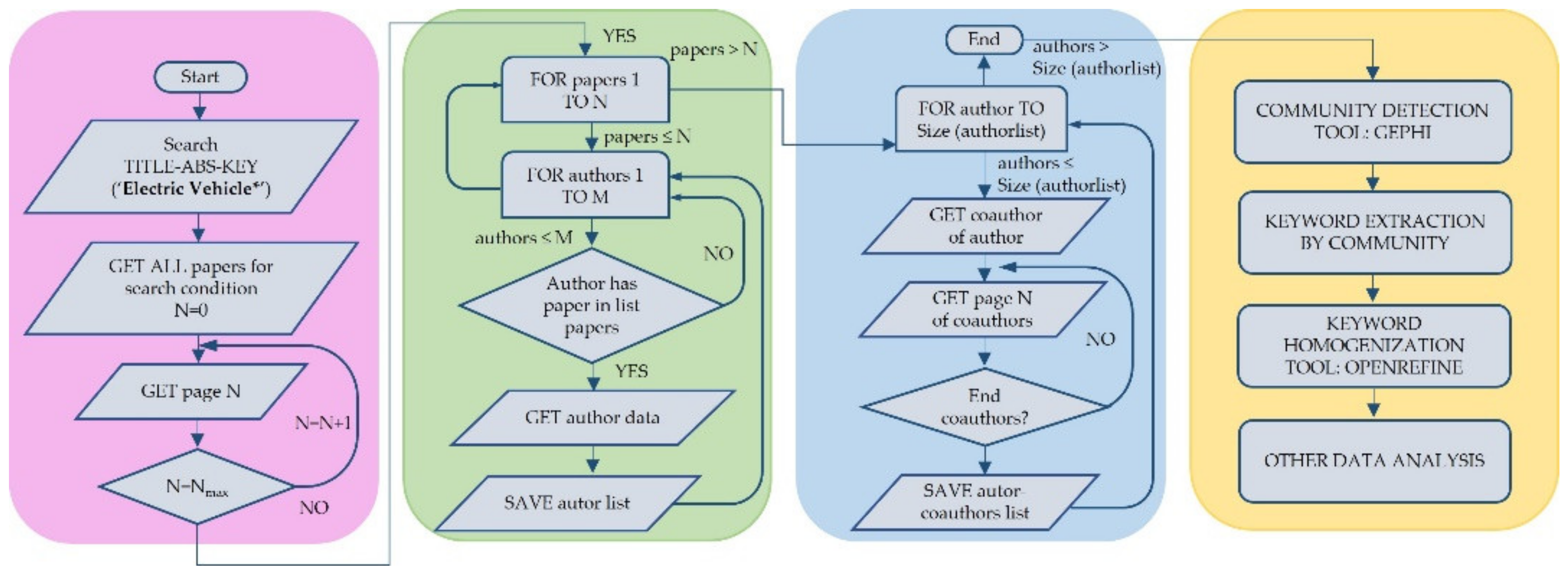
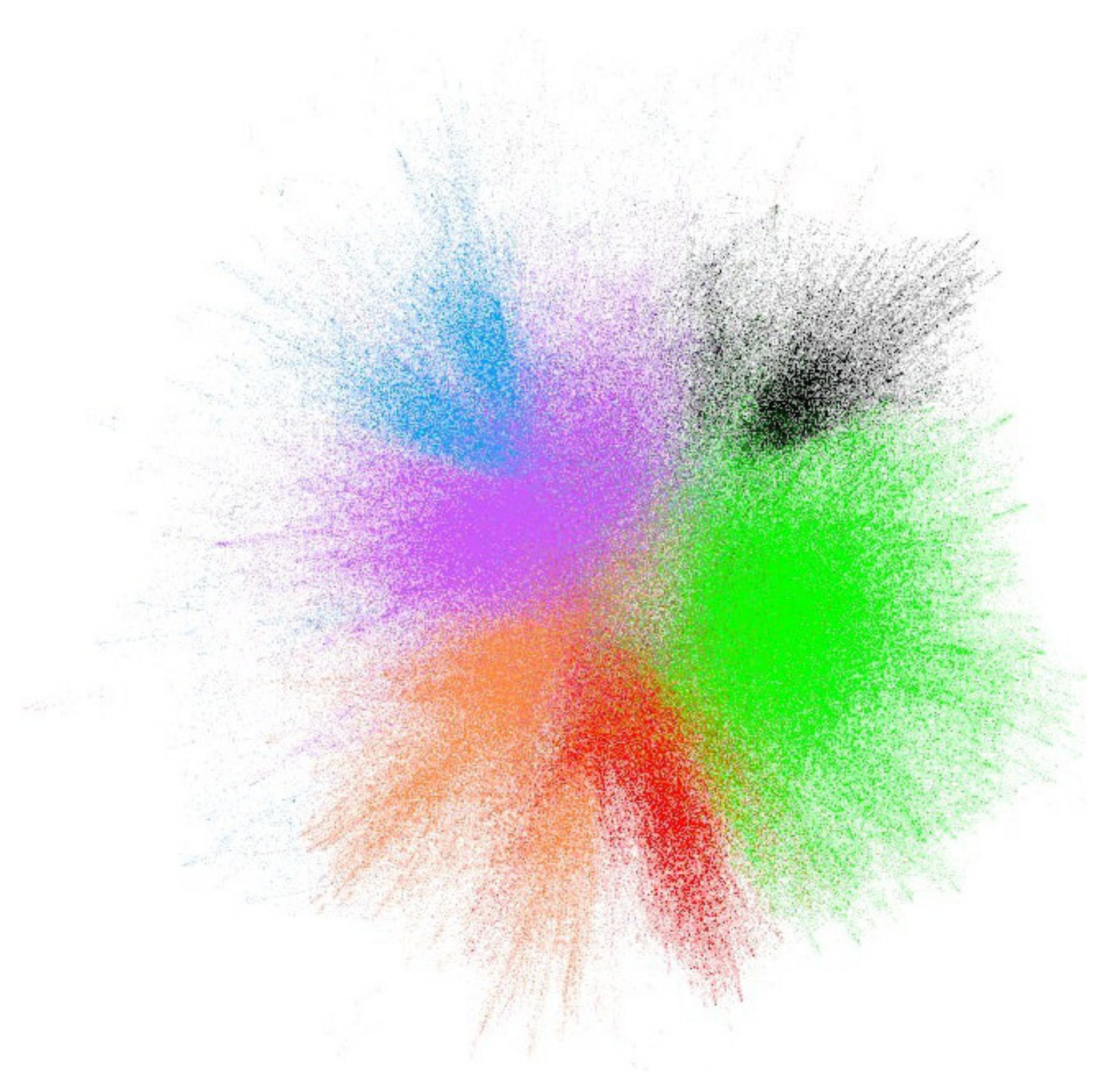
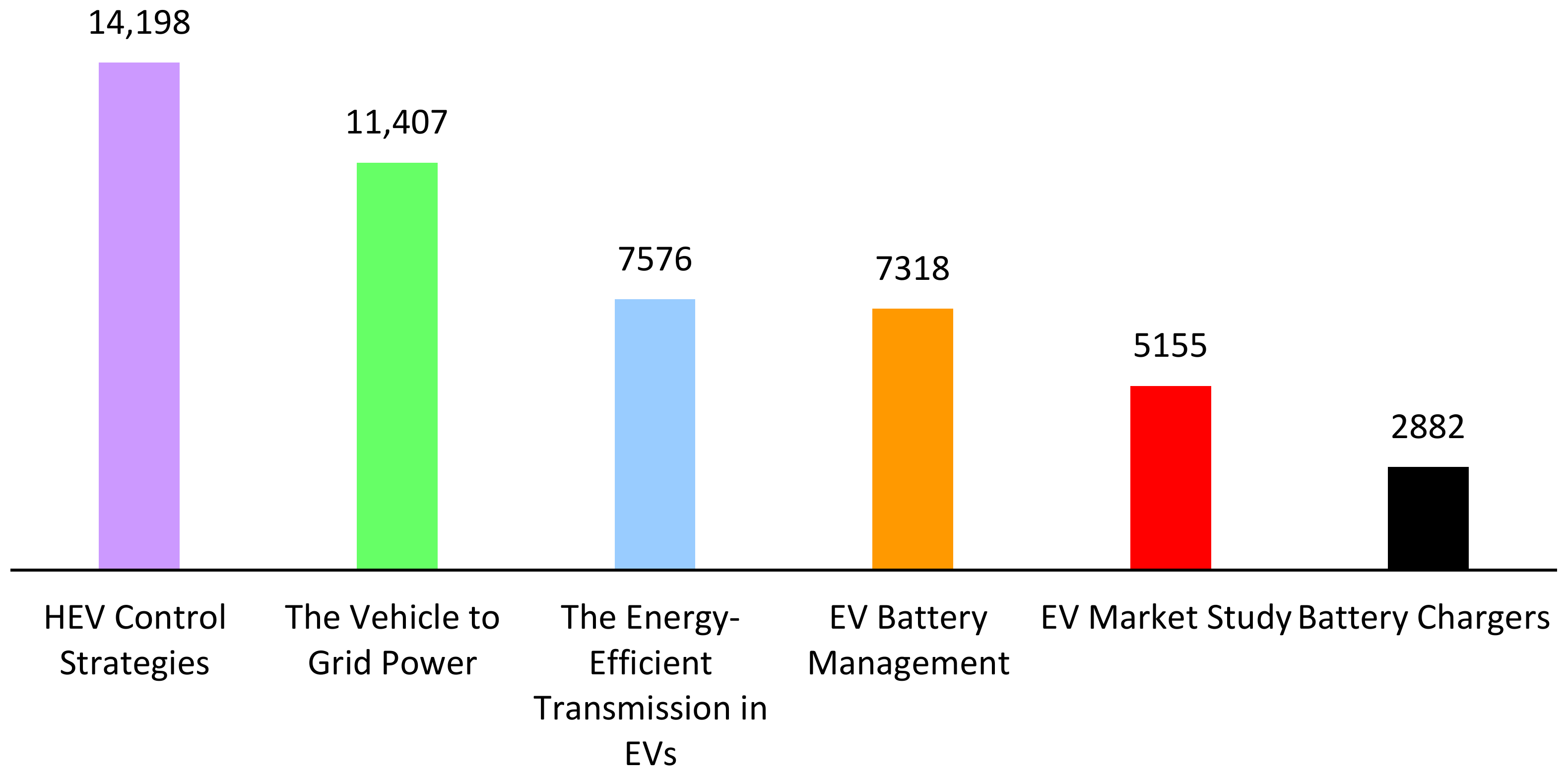
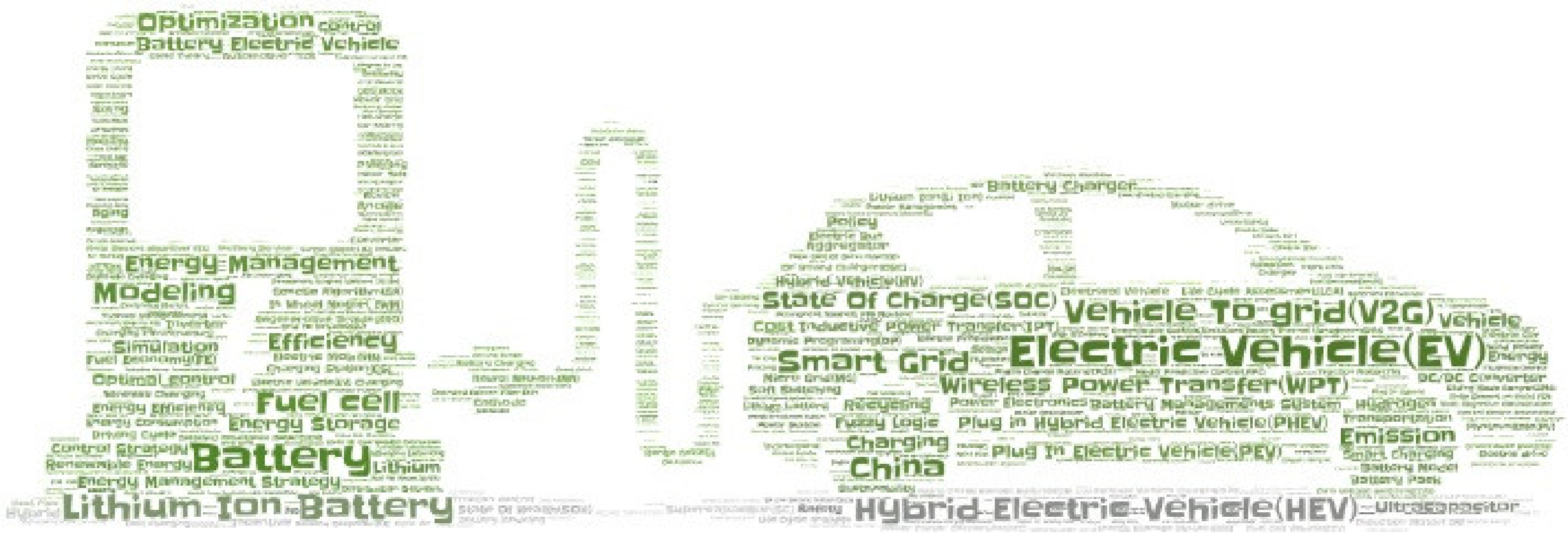
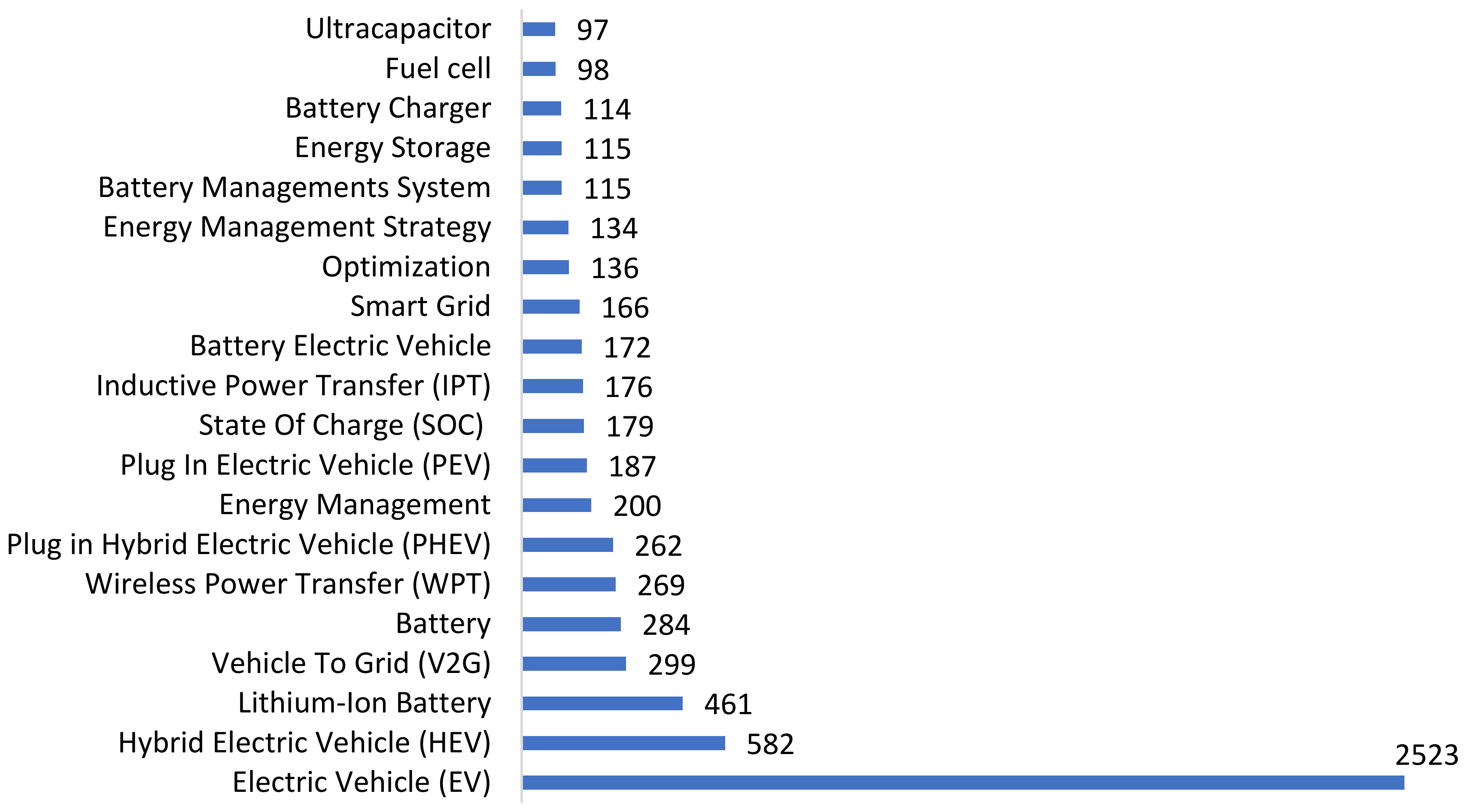
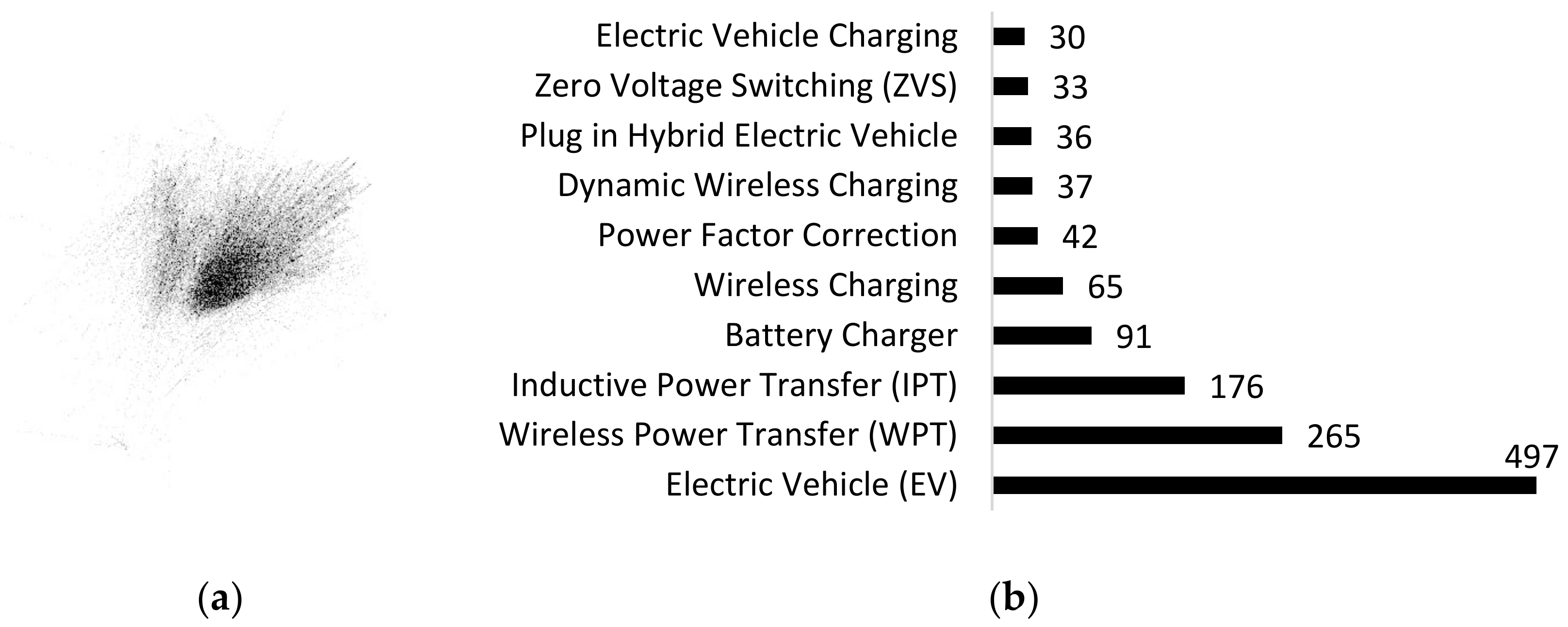

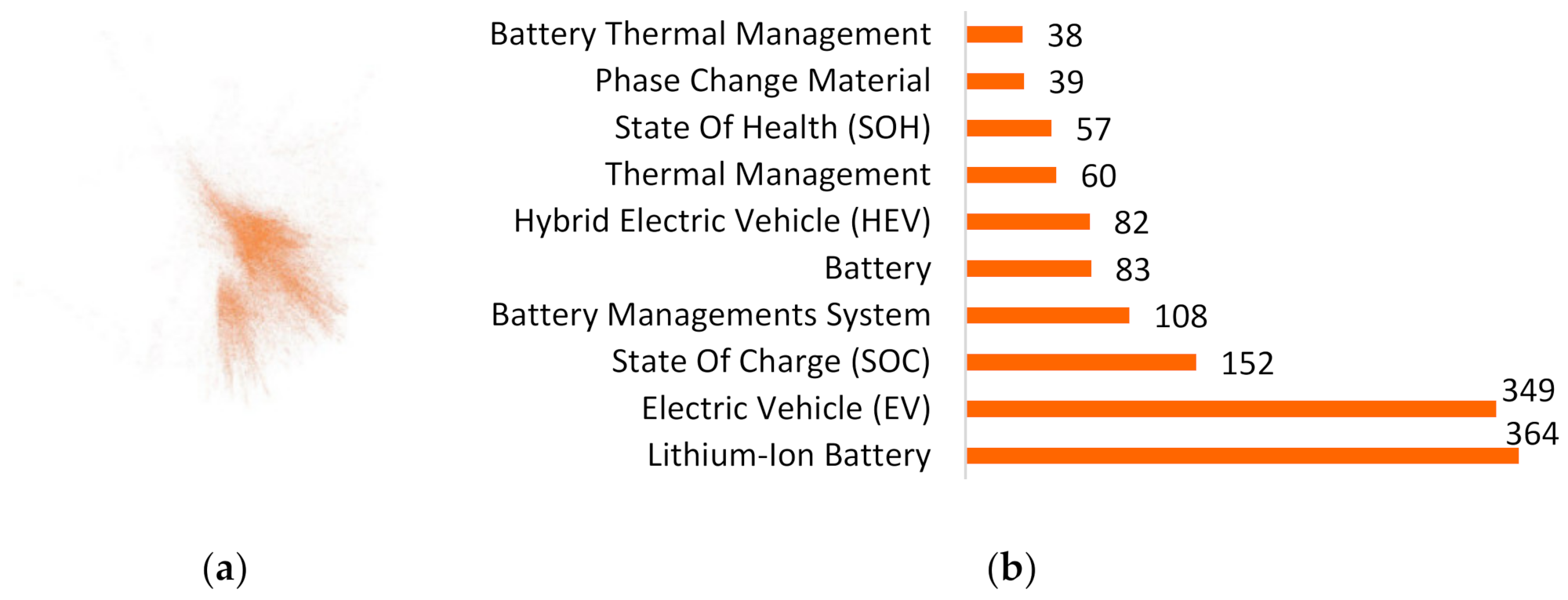
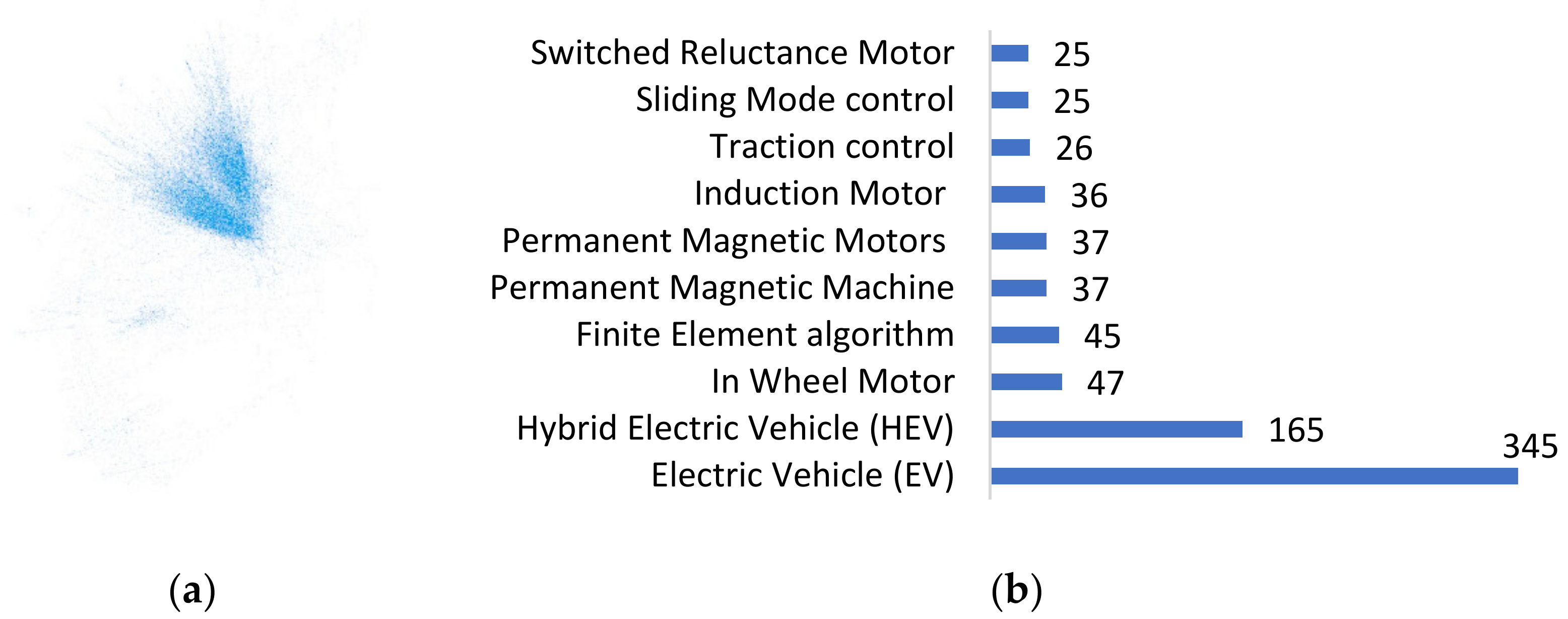

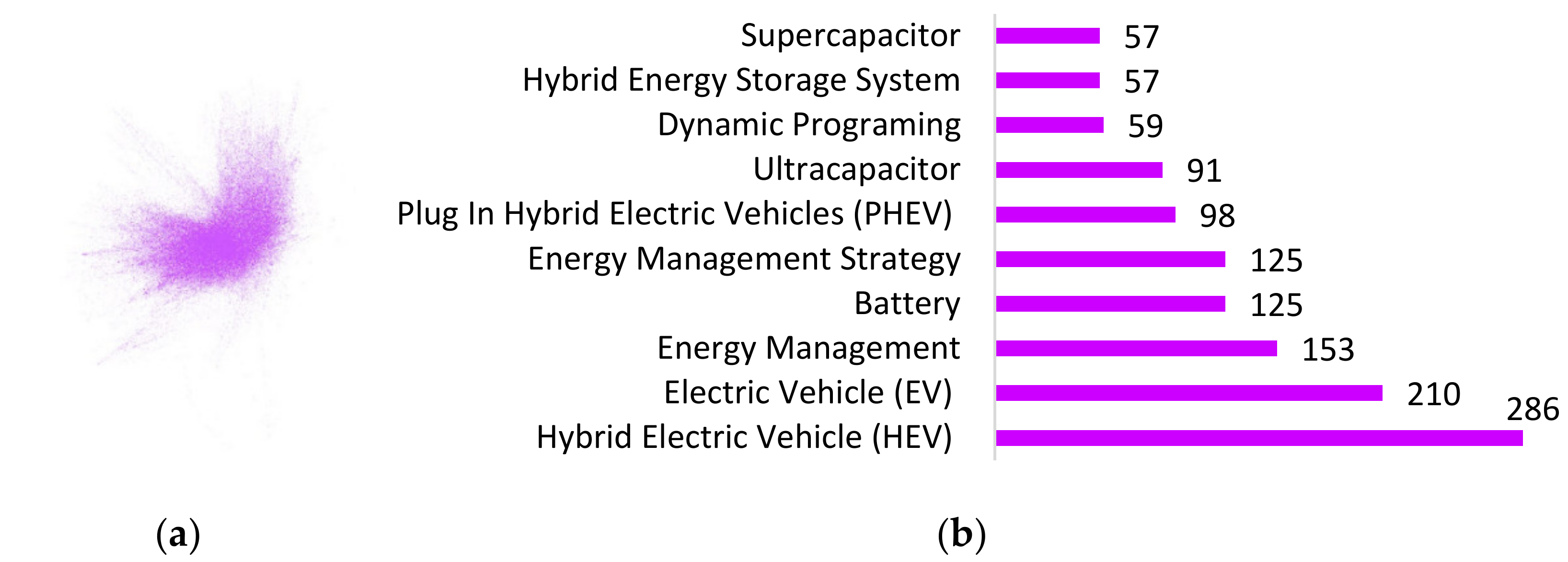
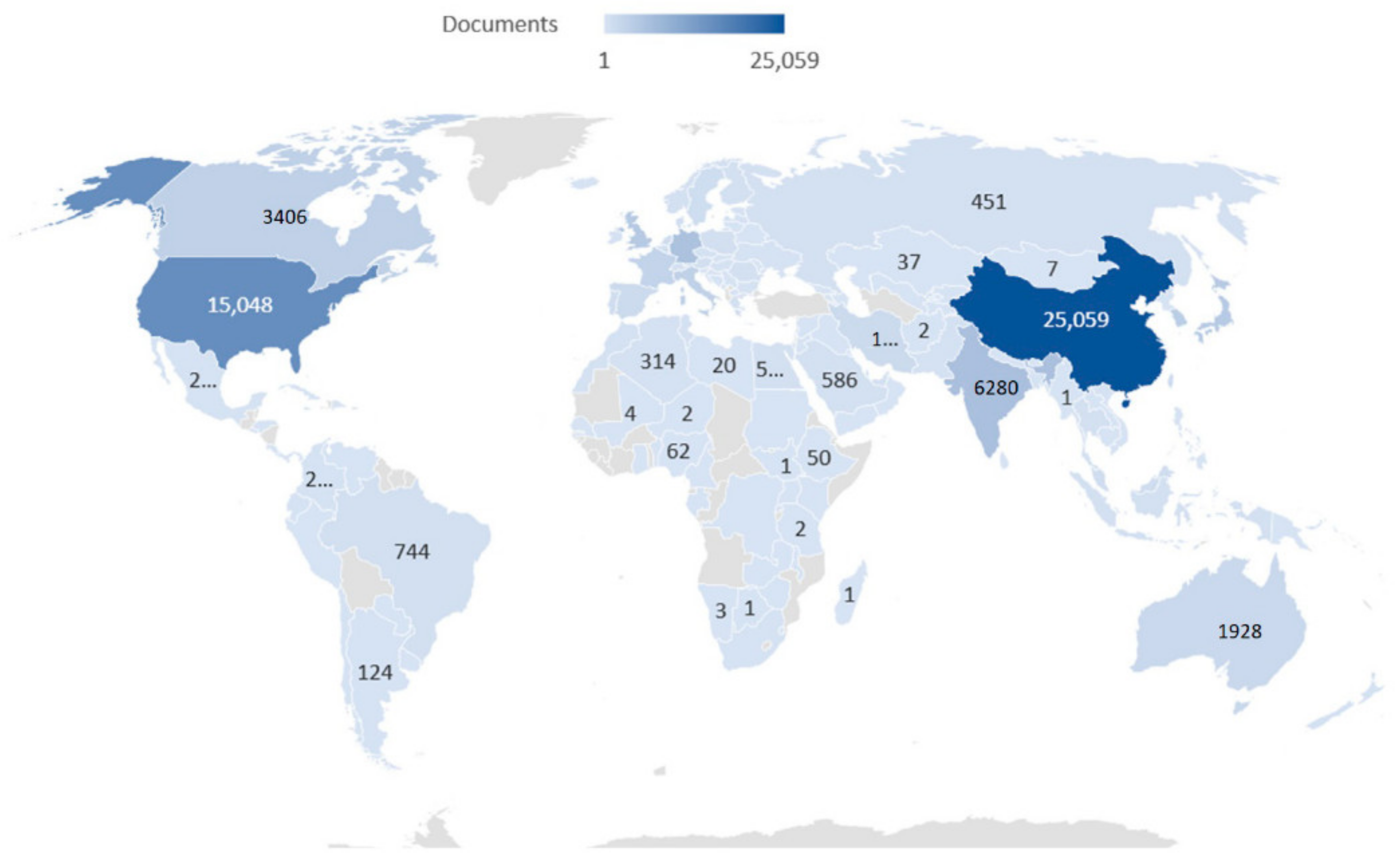
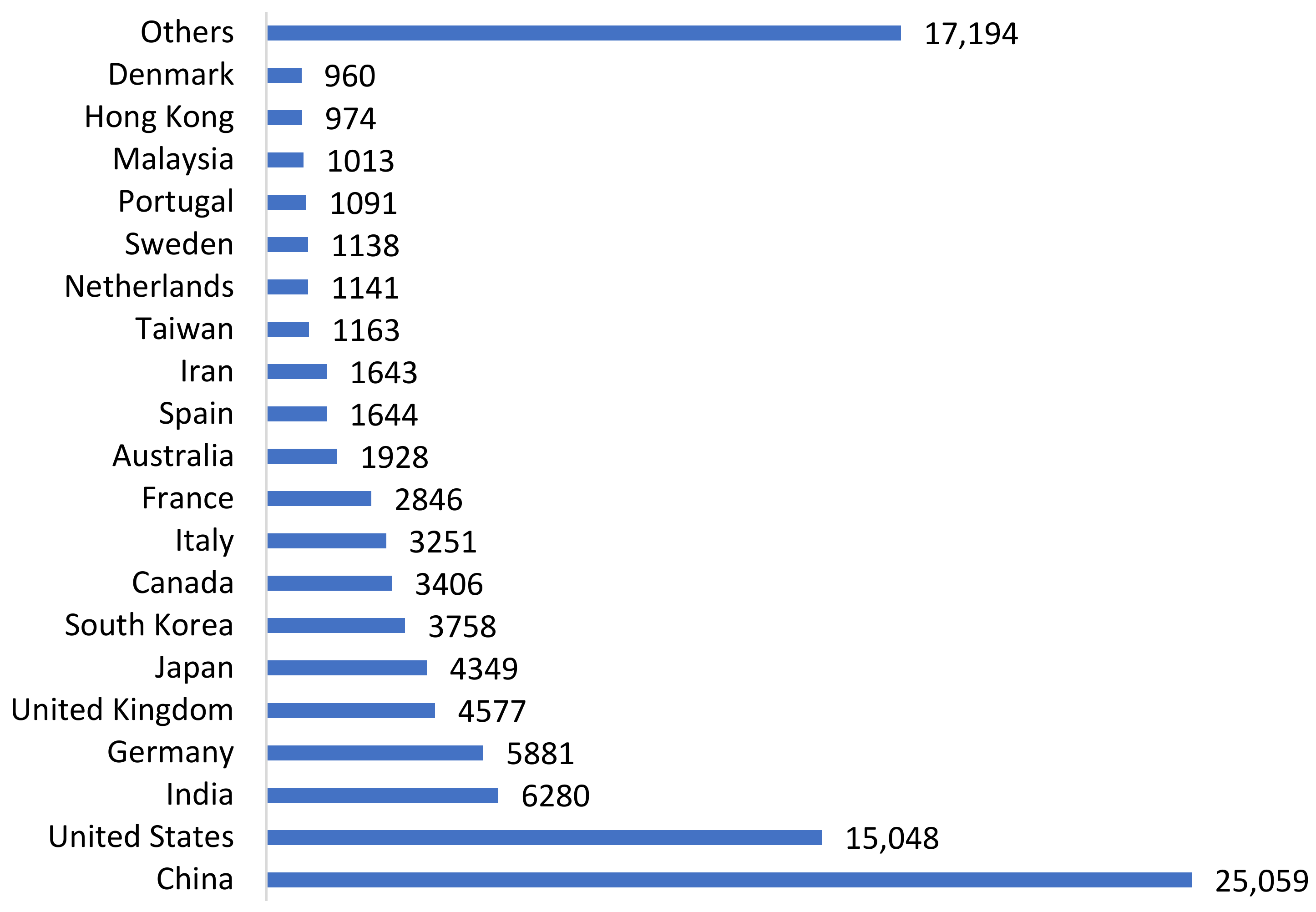
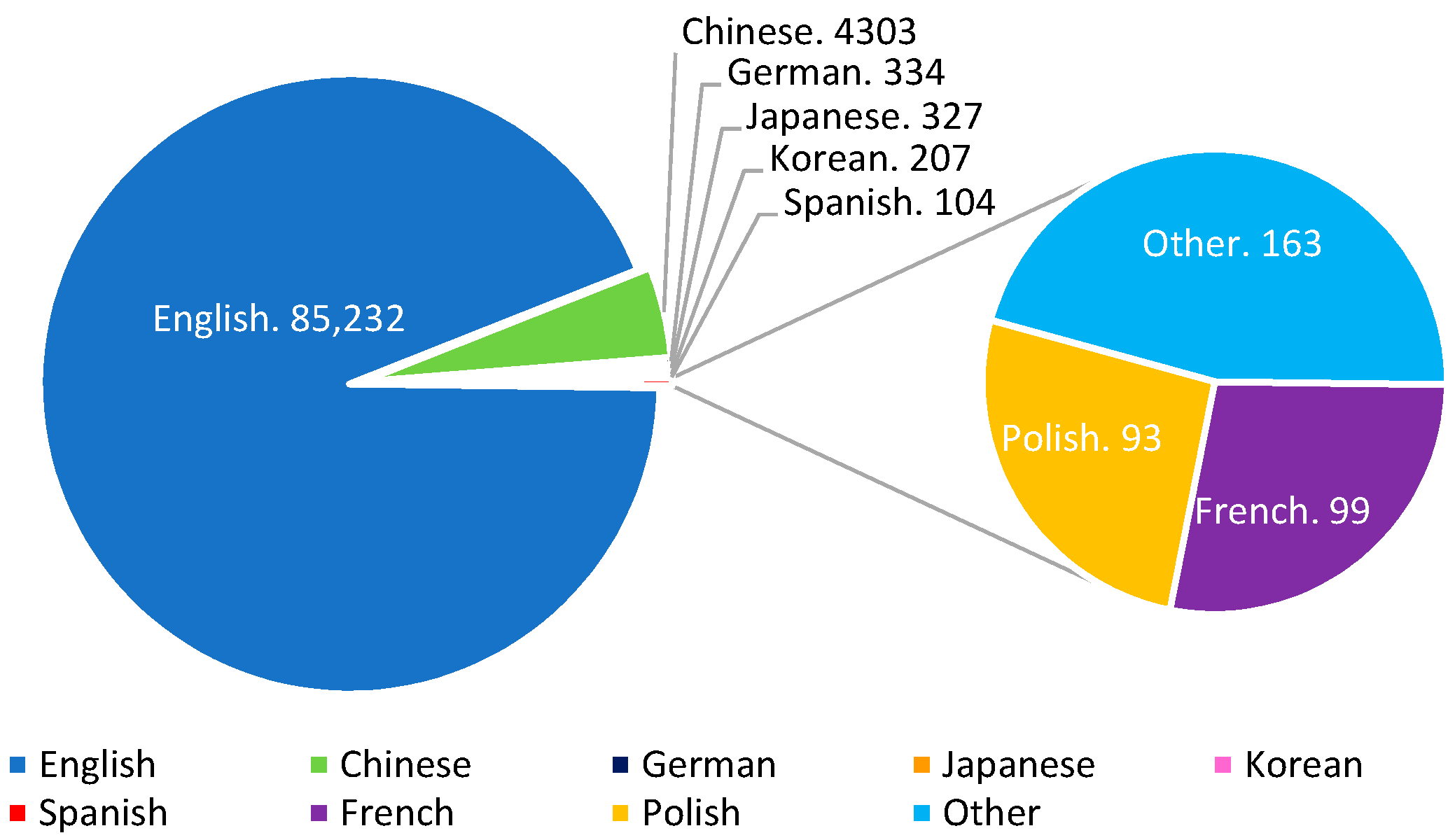
| Indexed Name | H- Index | Citation Count | Document Count | Country | University | First Publication (Year) |
|---|---|---|---|---|---|---|
| Gogotsi, Y. | 180 | 160,412 | 936 | United States | Drexel University | 2005 |
| Dai, L. | 148 | 86,083 | 662 | United States | Case Western Reserve University | 2006 |
| Blaabjerg, F. | 148 | 113,037 | 2912 | Denmark | Aalborg Universitet | 2005 |
| Beck, H. | 139 | 100,327 | 1460 | Switzerland | University of Bern | 2007 |
| Liu, J. | 138 | 80,785 | 496 | China | Beijing Forestry University | 2014 |
| Amine, K. | 136 | 62,151 | 680 | United States | Stanford University | 2016 |
| Chapín, F. | 135 | 100,129 | 432 | United States | University of Alaska Fairbanks | 2005 |
| Chen, J. | 134 | 63,266 | 583 | China | Nankai University | 2005 |
| Aurbach, D. | 131 | 71,805 | 738 | Israel | Bar-Ilan University | 2010 |
| Poor, H. | 130 | 78,631 | 2150 | United States | Princeton University | 2013 |
| Liu, H. | 129 | 64,488 | 1206 | Australia | University of Wollongong | 2005 |
| Dou S. | 128 | 75,307 | 1875 | Australia | University of Wollongong | 2014 |
| Sun, Y. | 127 | 64,493 | 702 | South Korea | Hanyang University | 2013 |
| Liu, M. | 126 | 54,155 | 732 | United States | Georgia Institute of Technology | 2005 |
| Gao, H. | 123 | 46,696 | 719 | China | Harbin Institute of Technology | 2005 |
| Gao, F. | 123 | 46,696 | 719 | China | Nanjing Agricultural University | 2009 |
| Kuss, M. | 116 | 46,395 | 337 | Italy | Istituto Nazionale di Fisica Nucleare, Sezione di Pisa | 2007 |
| Giannakis, G. | 114 | 52,728 | 1153 | United States | University of Minnesota Twin Cities | 2010 |
| Cho, J. | 114 | 48,489 | 389 | South Korea | Ulsan National Institute of Science and Technology | 2005 |
| Wong, C. | 114 | 52,241 | 1570 | United States | Georgia Institute of Technology | 2005 |
Publisher’s Note: MDPI stays neutral with regard to jurisdictional claims in published maps and institutional affiliations. |
© 2022 by the authors. Licensee MDPI, Basel, Switzerland. This article is an open access article distributed under the terms and conditions of the Creative Commons Attribution (CC BY) license (https://creativecommons.org/licenses/by/4.0/).
Share and Cite
Novas, N.; Garcia Salvador, R.M.; Portillo, F.; Robalo, I.; Alcayde, A.; Fernández-Ros, M.; Gázquez, J.A. Global Perspectives on and Research Challenges for Electric Vehicles. Vehicles 2022, 4, 1246-1276. https://doi.org/10.3390/vehicles4040066
Novas N, Garcia Salvador RM, Portillo F, Robalo I, Alcayde A, Fernández-Ros M, Gázquez JA. Global Perspectives on and Research Challenges for Electric Vehicles. Vehicles. 2022; 4(4):1246-1276. https://doi.org/10.3390/vehicles4040066
Chicago/Turabian StyleNovas, Nuria, Rosa M. Garcia Salvador, Francisco Portillo, Isabel Robalo, Alfredo Alcayde, Manuel Fernández-Ros, and Jose A. Gázquez. 2022. "Global Perspectives on and Research Challenges for Electric Vehicles" Vehicles 4, no. 4: 1246-1276. https://doi.org/10.3390/vehicles4040066
APA StyleNovas, N., Garcia Salvador, R. M., Portillo, F., Robalo, I., Alcayde, A., Fernández-Ros, M., & Gázquez, J. A. (2022). Global Perspectives on and Research Challenges for Electric Vehicles. Vehicles, 4(4), 1246-1276. https://doi.org/10.3390/vehicles4040066











